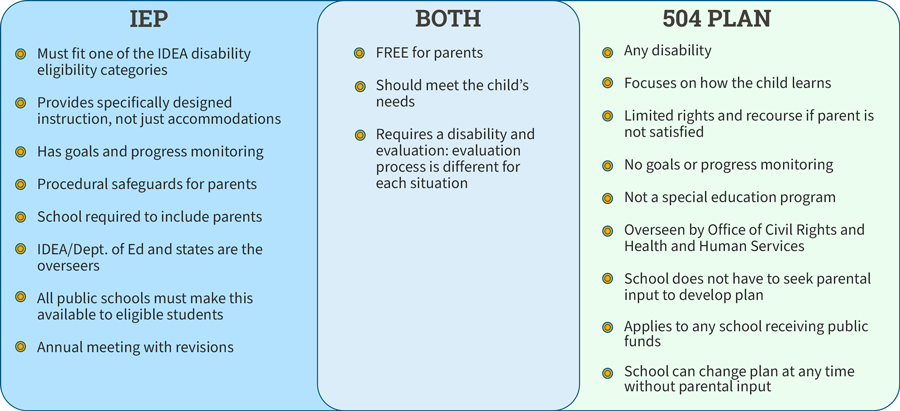What is a 504 vs IEP?
What is a 504 vs IEP?
As we previously discussed, there are many ways to get services and supports for your student who is struggling in school. The first are universally provided supports available to all students. Universal supports are those strategies that the teacher can implement in the classroom or those extra enhancements that might be available, like reading groups, positive reinforcement, or differentiated learning.
If these types of strategies are not working, then a Multidisciplinary Team (MDT) will be called to further explore options for your child. As we mentioned earlier, this occurs in the Initial Evaluation that can be requested by parents or the school Multidisciplinary Team (MDT).
The Initial Evaluation will progress in one of three directions. A finding that:
- Your child requires no additional services beyond what is currently being provided.
- Your child qualifies for Special Education Services based on having one of the 13 previously mentioned disabilities that are adversely affecting their education and require specialized services. If you agree that special education services are appropriate for your child, then the next step will be to develop your child's Individualized Education Program (IEP).
- Your child does not qualify for special education services, but still is dealing with a mental or physical impairment. An example of this is a child struggling to pay attention due to ADHD. In this case, a 504 plan might be an option.
IEP and 504 Plan Comparison
The 504 Plan is a federal regulation that protects the rights of students who have a disability or impairment that limits one or more major life activities. Examples that might qualify for a 504 plan include disabilities/impairments such as diabetes, epilepsy, ADHD, asthma, anxiety and more.
Examples of some reasonable accommodations for a student with a 504 Plan include:
- A change in classroom seating
- Extra time for assignments or tests
- Administration of medication
- Daily check-in with teachers
- Behavioral contract
- Access to assistive technology
- Breaking tasks into parts
In contrast to the 504 Plan, special education services require an Individualized Educational Program (IEP) be created. The IEP documents your child's needs, services that will be provided, and progress toward goals. The IEP will include accommodations similar to the 504 Plan, but it also provides individualized instruction by a resource teacher or provider and documents the number of service minutes your child will receive.
We will talk much more about special education services in the series focused on planning special education support, called “Understanding my child's IEP." Here are highlights of the differences and similarities between IEPs and 504 plans.

Regardless of whether your child is on a 504 Plan or has an IEP, your input is essential for your child's success. The IEP has more formal opportunities for parental involvement than the 504 Plan, but parents are encouraged to bring up concerns regardless, either during annual review meetings or specific meetings that you request to address your child's needs throughout the year.
Helpful Handouts
Additional Resources
Coming Up Next
IN ISSUE 5 Your Voice and Rights as a Parent